
The Porsche 993 was the last 911 with an air-cooled six-cylinder boxer engine, or flat-six. The 2+2-seater sports car was launched for the 1994 model year and was built until 1998. It was available as a Coupe, Targa, Cabrio and – at least twice – as a Speedster. Withe the 993, 30 years after the 901, Porsche made its first radical change to the design of the rear-engined sports car. With 68,881 units built, the fourt-generation 911 is one of the rarest along with its predecessor, the 964.
Urlich Bez as the new Chief Development Officer was to drive the Porsche 989 project forward with the new Style Porsche boss Harm Lagaay from 1988. The development of this four-door sedan had internal priority at the time. In 1989, the “Facelift 911” project also began. Project manager Bernd Kahnau commented: “The 993 was actually developed by the second guard. It had already been clear that the Porsche 993 would be the last classic 911.”

Ulrich Bez had told him at the time that the 911 had no future anyway. Originally, the Porsche board member responsible for development at the time saw the 993 merely as a cash cow that would pay for engine development for the 989. The specifications for the 993 were clear: It should be able to do more than the 964, have a completely new design, but not cost more than the 964.
If the 993 comes to nothing, Porsche is finished.
Bernd Kahnau, Project Manager Porsche 993 to his development team 1991
In 1991, however, the 989 project was completely discontinued and Ulrich Bez had to leave the company. At that time, Porsche was recording losses of up to DM 240 million in the fiscal year and was not even selling 20,000 cars in 1991. Since the ultimately discontinued developments of 989 and 965, a more powerful version of the 964, had swallowed up a lot of money and little development budget was available, many employees were laid off. In the wake of the corporate earthquake, Bernd Kahnau swore in his team with the words: “If the 993 comes to nothing, Porsche is finished.”
With Wendelin Wiedeking as Chairman of the Executive Board, Porsche’s management was turned upside down during the development of the 993. As with the management team, the new 911 was also extensively reworked. Its predecessor, the 964, was technically new in many respects, but visually it was considered antiquated. It was also clear early on in the development of the 993 that the later 996 would share many of the same parts with a less expensive sports car positioned below it. Therefore, the technical design remained a cautious evolution.
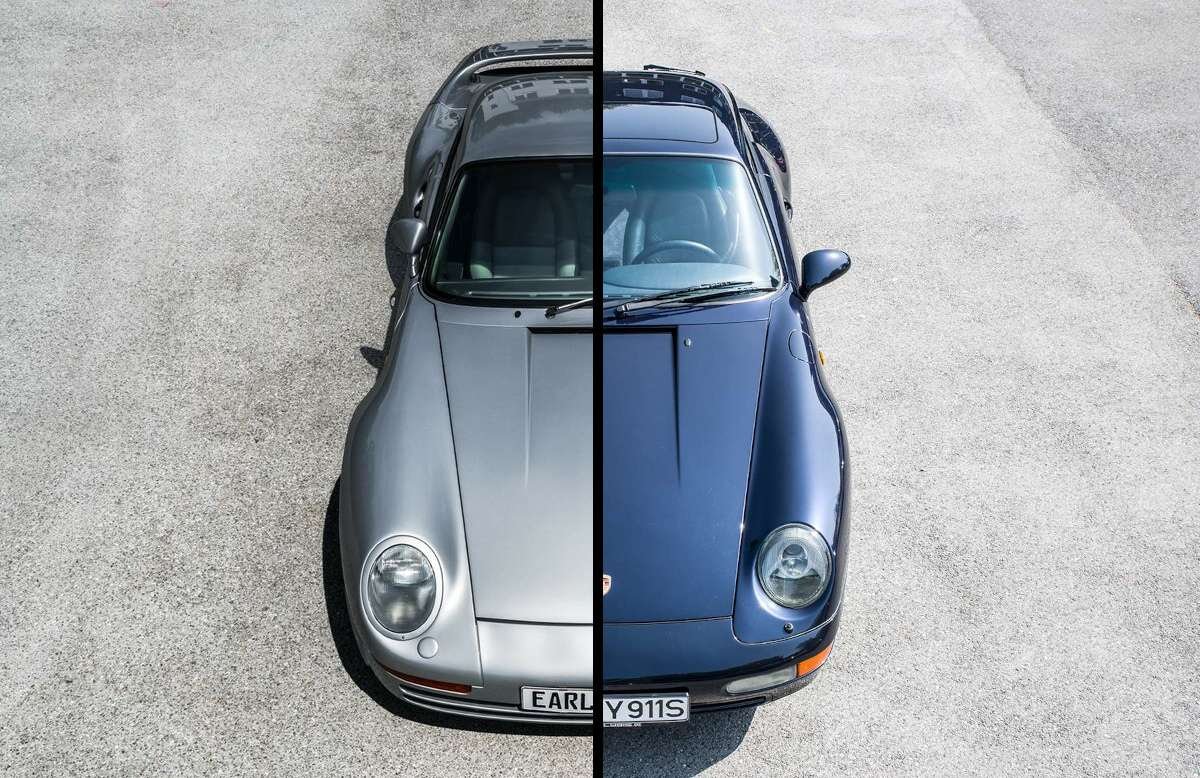
But visually, the design team dared to carry out a small revolution. Apart from the roofline, no stone was left unturned on the Porsche 993. Tony Hatter’s design borrowed from the Porsche 928 and 959 to give the 993 a flatter front end. For example, redesigned polyellipsoid headlights greeted from the front from wider, but lower fenders. At the same time, the trunk lid was raised by 40 millimeters. In addition, the last air-cooled 911 was adorned with a significantly more accentuated hip curve at the rear fender and a straighter line from there to the rear of the vehicle.
Chrome bumpers and impact bumpers were already followed by a break on the 964. However, its protruding front and rear skirts were not to everyone’s liking, because the rear bumper in particular created a break in the silhouette. The designers were determined to clean that up. According to an interview in the anniversary book Porsche 993 – 25 Years, the main focus for designer Tony Hatter was a better balance between front and rear. And it really had to look new.
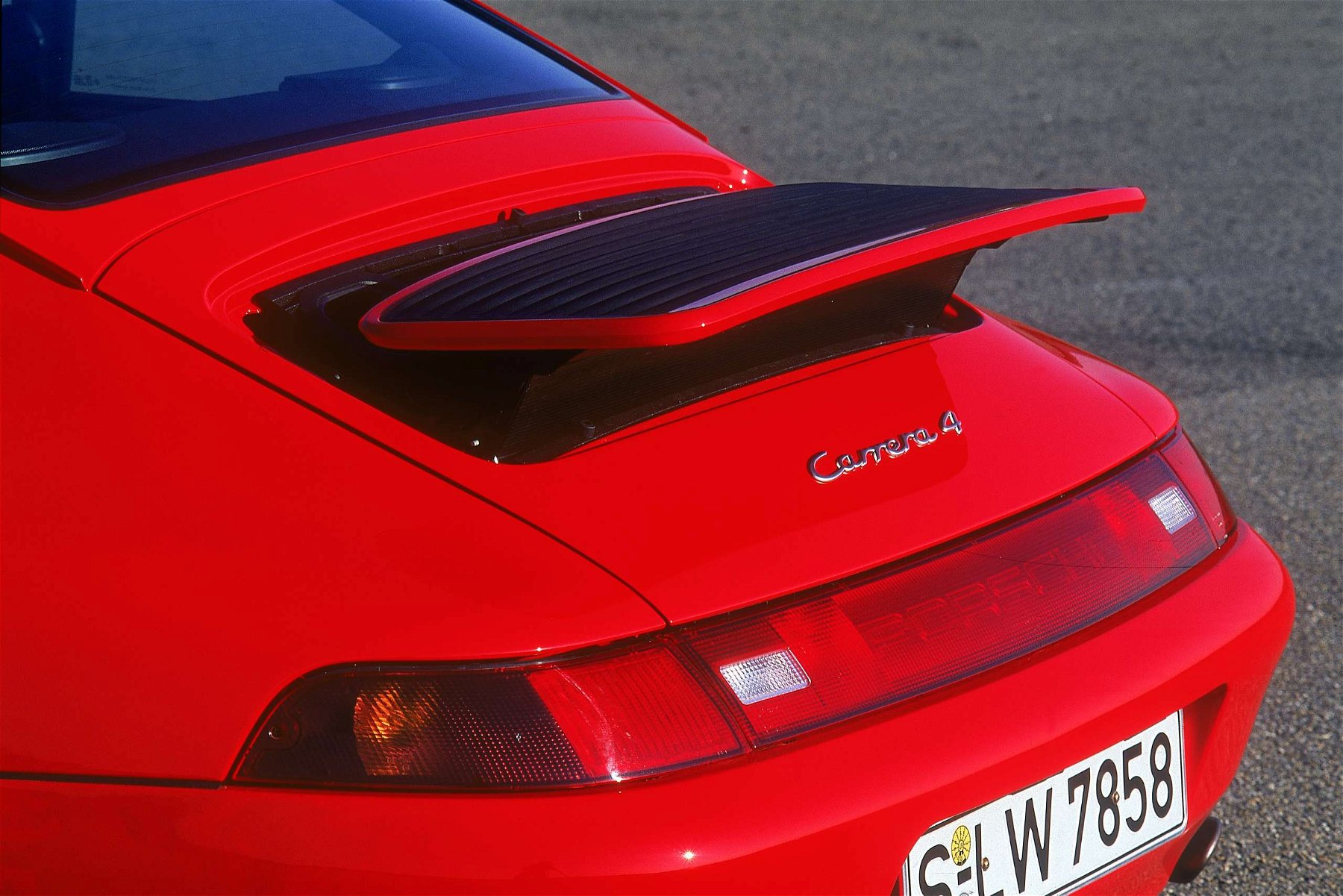
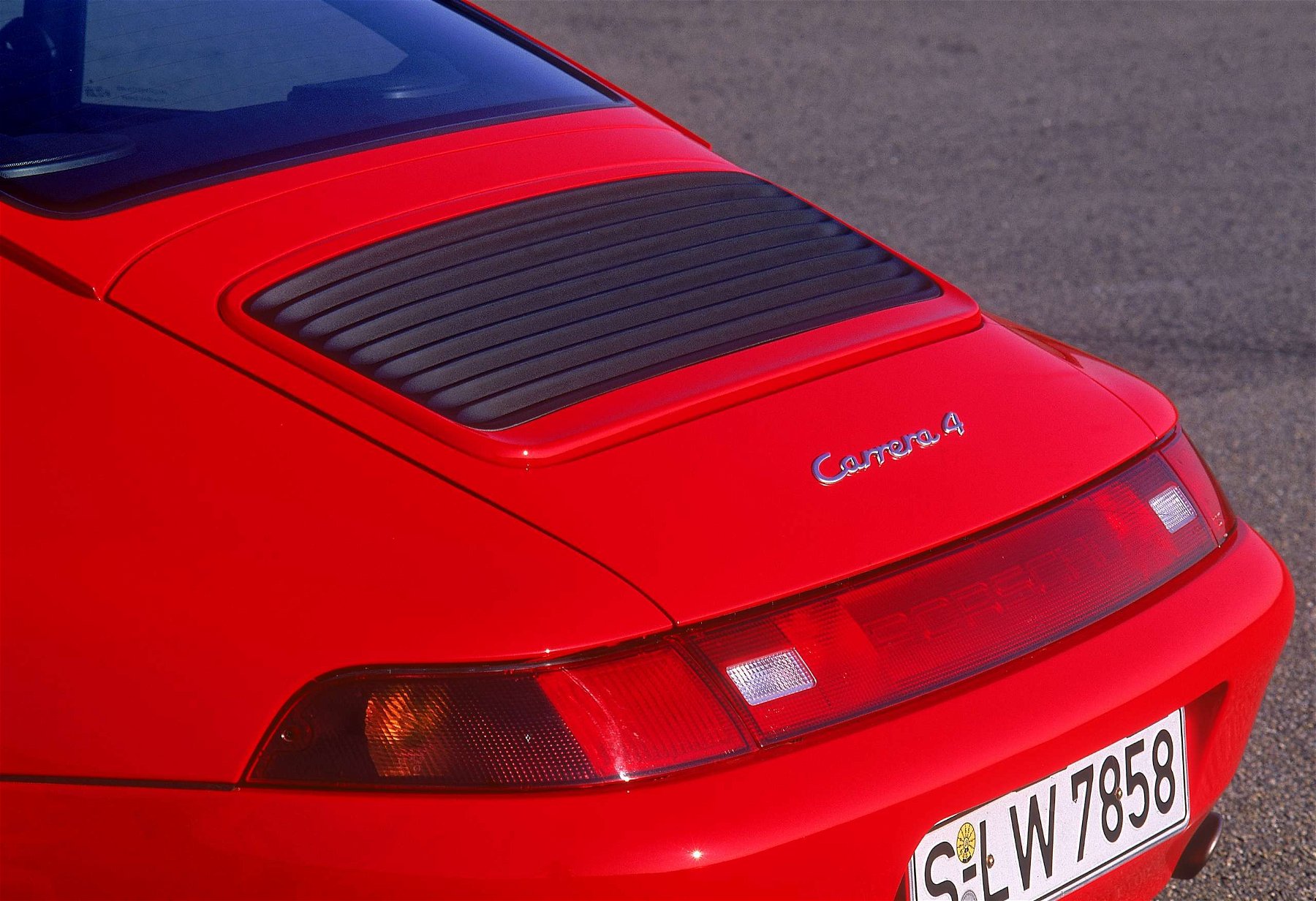
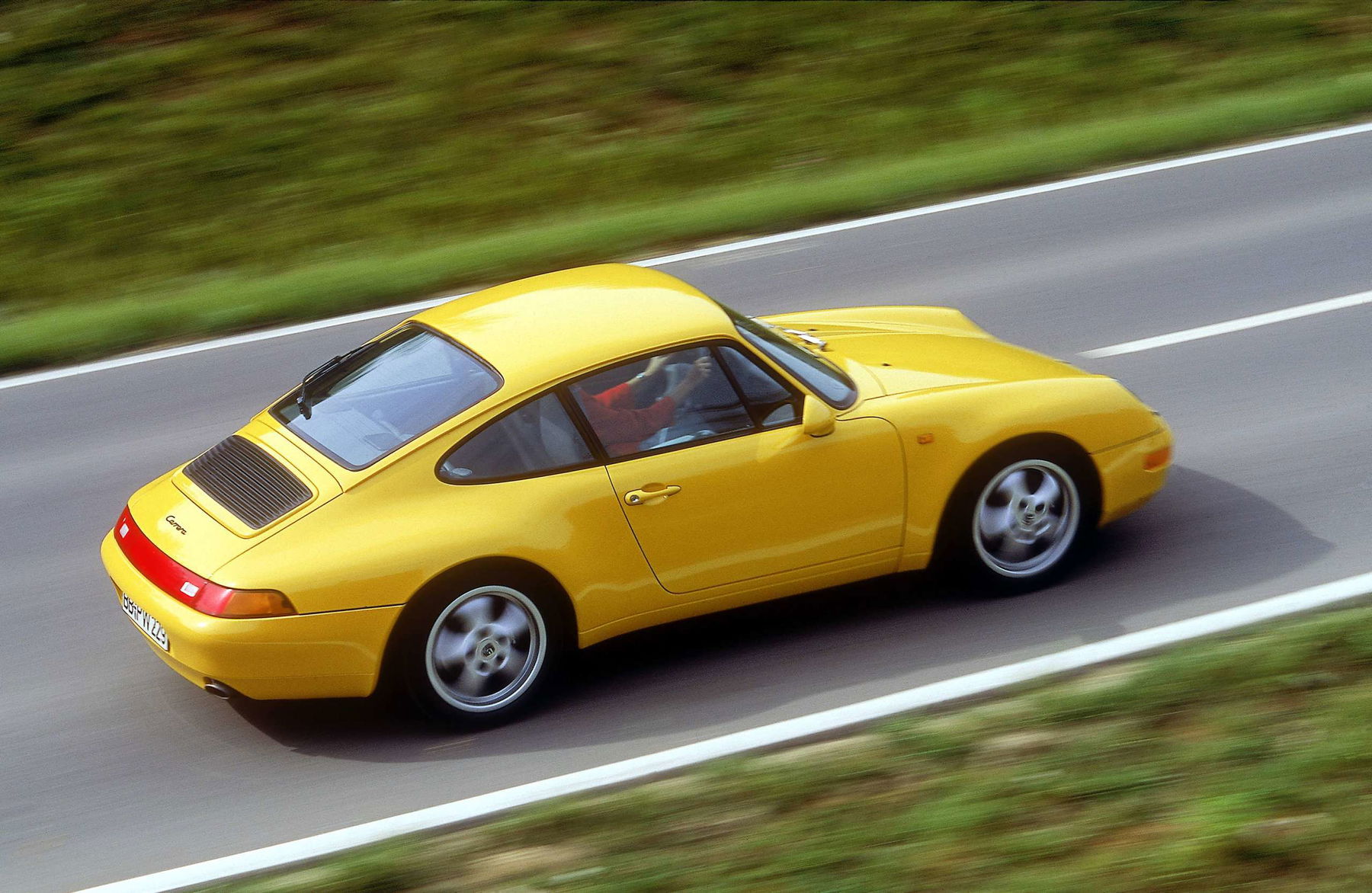
In fact, this objective was fully met with the Porsche 993 presented at the Frankfurt IAA in 1993. The visually rejuvenated 911 appeared considerably refreshed and much more contemporary. Only the roof and doors remained from the 964. For the first time, the windows and the retractable spoiler on the engine cover were flush with the bodywork. But the new 911 did not deny its history. Actually, it looked like the logical further development of the basic form created by Ferdinand Alexander Porsche.
Everything looked as if it had been cast from a single mold and blended into a harmonious overall picture. After the F-Model, the Porsche 993 was the first 911 that almost everyone liked. That also applies to the interior. Of course, the competition, such as the BMW 8-Series, had more daring and modern interiors on offer. But the five round instruments, further improved seats and haptically upgraded switch units were also a welcome step into the modern age without forgetting tradition.



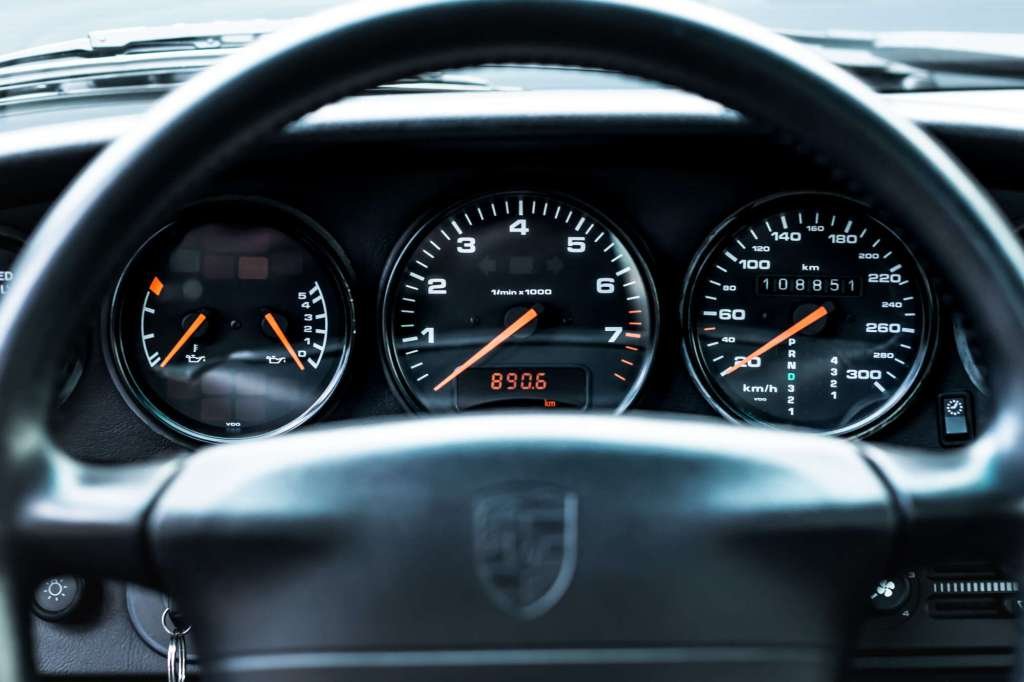
Originally, the Porsche 993 was already to have a water-cooled engine in the rear. Porsche also considered the V8 engine developed for the 989. For this reason, there were even test cars with an eight-cylinder engine from Audi. However, the decision in favor of an air-cooled six-cylinder unit was still made in 1988. Although there were plans and initial developments of water-cooled cylinder heads, these also fell victim to the need to save money in 1991.
Nevertheless, the last stage of expansion of air-cooled Porsche engines was to get at least 270 hp and also be more economical than its predecessor’s unit. Its fundamental design was based on the 964’s 3.6-liter engine. Bore, stroke and dual ignition remained the same. But lighter pistons and connecting rods, a stiffer crankshaft and adapted intake provided 272 hp in the launch specification.

Porsche was particularly proud of the reduced maintenance effort. For example, the hydraulic valve clearance adjustment eliminates the need for regular valve clearance checks during the major service. A Porsche 993 engine therefore devours only half the maintenance costs of its predecessor. The Porsche 911 also received a 6-speed transmission for the first time.
While no great leaps were possible on the powertrain side, Porsche used a development from the discontinued 989 project. The rear axle used in the 993 was actually intended for the four-door sedan. By attaching the rear axle to a rubber-mounted auxiliary structure, Porsche killed several birds with one stone.

On the one hand, the new design reduced rolling noise. On the other hand, the significantly lighter LSA rear axle (lightweight, stability, agility) ensured less pitching and rolling. In addition, it prevented the rear wheels from pressing into toe-out during fast cornering. In other words, the wheels no longer point further out, but towards the inside of the corner. This drastically increased driving stability and took away many of the 911’s handling pitfalls.
The results of the chassis developments were impressive. In the slalom, the Porsche 993 Carrera even left the track-focused 964 Carrera RS behind. Despite all its sportiness, comfort and noise levels were even better than the 928’s. And those results unsettled new development board member Horst Marchart so much that he invited race drivers Hans-Joachim Stuck and Paul Frère, among others, to take a test drive. These attested to the excellent sports car qualities of the new 911. Nevertheless, for the first time Porsche offered a sports suspension from the factory with a further tightened set-up and 20 millimeters of lowering – just to play it safe.
At market launch, the Porsche 993 was only available as a rear-wheel drive Carrera Coupé. More diversification or other performance levels were initially not possible due to the limited development budget and only came later in the model series cycle. The same was true for all-wheel drive. Initially, however, there were very many orders for the new model and at the same time vehement demands for all-wheel drive, especially from the Alpine republics of Switzerland and Austria.

Porsche hastily developed a new all-wheel drive system. While the predecessor of the Type 964 had permanent all-wheel drive with a transfer case, Porsche came up with a lighter solution for the 993. A passive viscous clutch sent drive power to the front wheels only when a certain difference in speed between the front and rear wheels was detected. This largely preserved the dynamic character of the rear-wheel drive car, with only 50 kg of additional weight.
When Wendelin Wiedeking took over as CEO, a fresh wind blew through the Porsche Group. Production in particular was to become more efficient. Wiedeking and his management flew to Japan to visit several automotive production plants. The lessons learned motivated the Stuttgart-based company to engage the Shin Gijutsu Company as a consultant for their own transformation. These experts were already responsible for the revolutionary restructuring of Toyota’s production.
Under the mantra of Kaizen, which means continuous change for the better, the consultants turned the entire company inside out. From management to production, nearly all Porsche employees were briefed. The impressive result was a 30 percent reduction in production time per vehicle and savings of over DM 70 million. As early as July 1996, Porsche broke the sound barrier of one million cars produced. The Porsche 993 is thus not only emblematic of the financial turnaround for the better. With it, a new corporate culture moved into Zuffenhausen, which ultimately made Porsche the most profitable sports car manufacturer in the world.
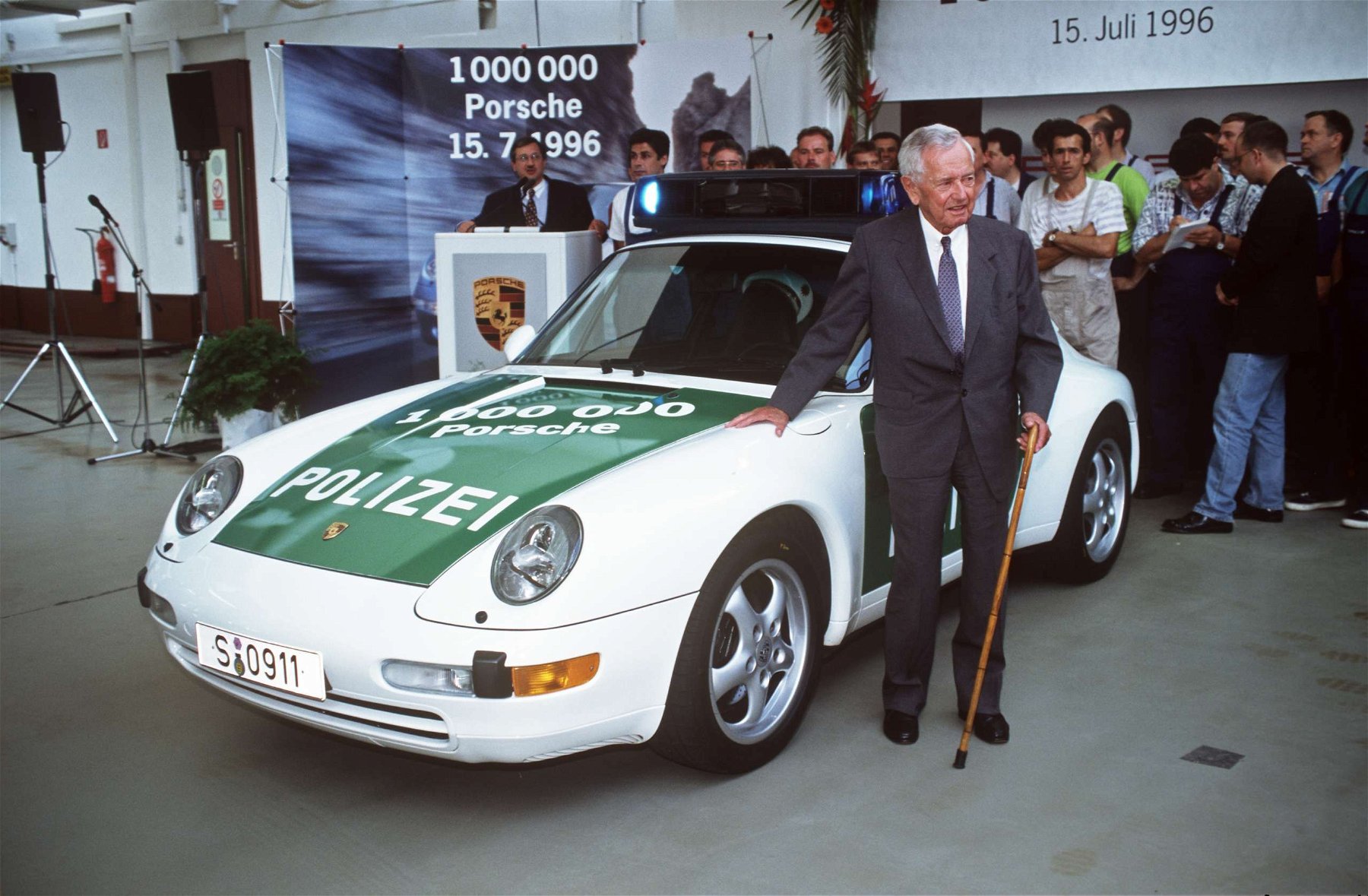
Initially, the Porsche 993 was only available as a rear-wheel drive Carrera Coupé at prices starting at DM 125,760. The 3.6 liter engine (type M64/05 or M64/06) produced 272 hp and 330 Nm of torque. With a measured 5.6 seconds (6.6 seconds with Tiptronic), it accelerated only imperceptibly faster than its predecessor from a standstill to 62 miles per hour. If that wasn’t enough for you, you had to go to the Porsche Exclusive department. There, the factory performance upgrade (WLS, equipment code X51) was already offered in the first model year.
It mainly consisted of replacement pistons and cylinders with a larger bore. As a result, the displacement of the WLS model was 3.8 liters (engine type M64/05 S or M64/06 S). Combined with changes to the camshafts and an adapted engine management system, the WLS produced a 13 hp increase in power and 20 Nm more torque. At 12,850 DM, however, it was not an inexpensive undertaking.
Engine Kit 2 offered an even more powerful version with 299 hp and 365 Nm (M64/05 R). However, the use of higher-speed rocker arms eliminated the possibility to use the maintenance-free valve clearance adjustment via hydraulic lifters. In addition, the conversion cost almost DM 24,000 and could not be combined with the Tiptronic transmission.
While the electric soft top on the Porsche 964 could only be opened with the engine switched off, on the Porsche 993 Carrera Cabrio delivered from spring 1994 it was sufficient to apply the handbrake. The Cabrio was optionally available with an integrated wind deflector. The surcharge for unlimited headroom at the push of a button was around DM 17,000 at market launch.
Technically, the all-wheel-drive Porsche 993 Carrera 4, available from fall 1994, largely corresponds to the rear-wheel-drive Carrera. Its engines are identical, as are the chassis and brakes for the most part. The Active Brake Differential (ABD), optional on the Carrera, is standard on the Carrera 4, as is the limited-slip differential. It enables targeted braking interventions to reduce drive slip.
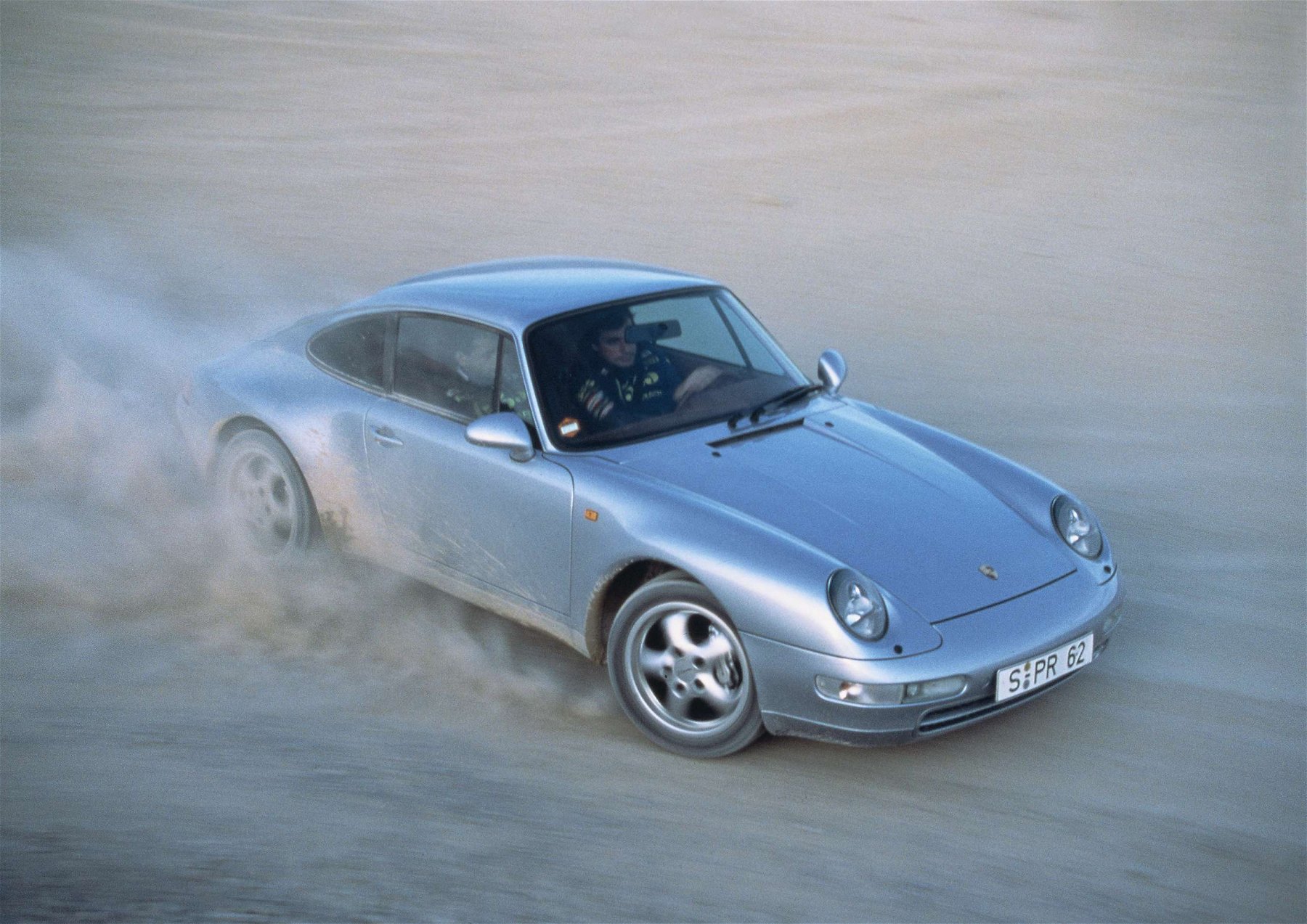
From the outside, the AWD-993 is recognizable by its titanium-colored instead of black brake calipers and white turn signal lenses at the front. At around DM 2,000, the surcharge for the all-wheel drive Porsche 993 Carrera 4 was relatively low. However, the 993 Carrera 4 was not available with Tiptronic, but only with a manual 6-speed transmission.
Full order books for the then-new Porsche 911 gave Zuffenhausen a little more financial predictability. Hence Porsche presented some innovations and also new models in 1995. For the first time, the Triptronic now had gearshift paddles on both sides of the steering wheel. It was now possible to shift up or down at the push of a button. In the same breath, the retrofittable system was renamed Tiptronic S.
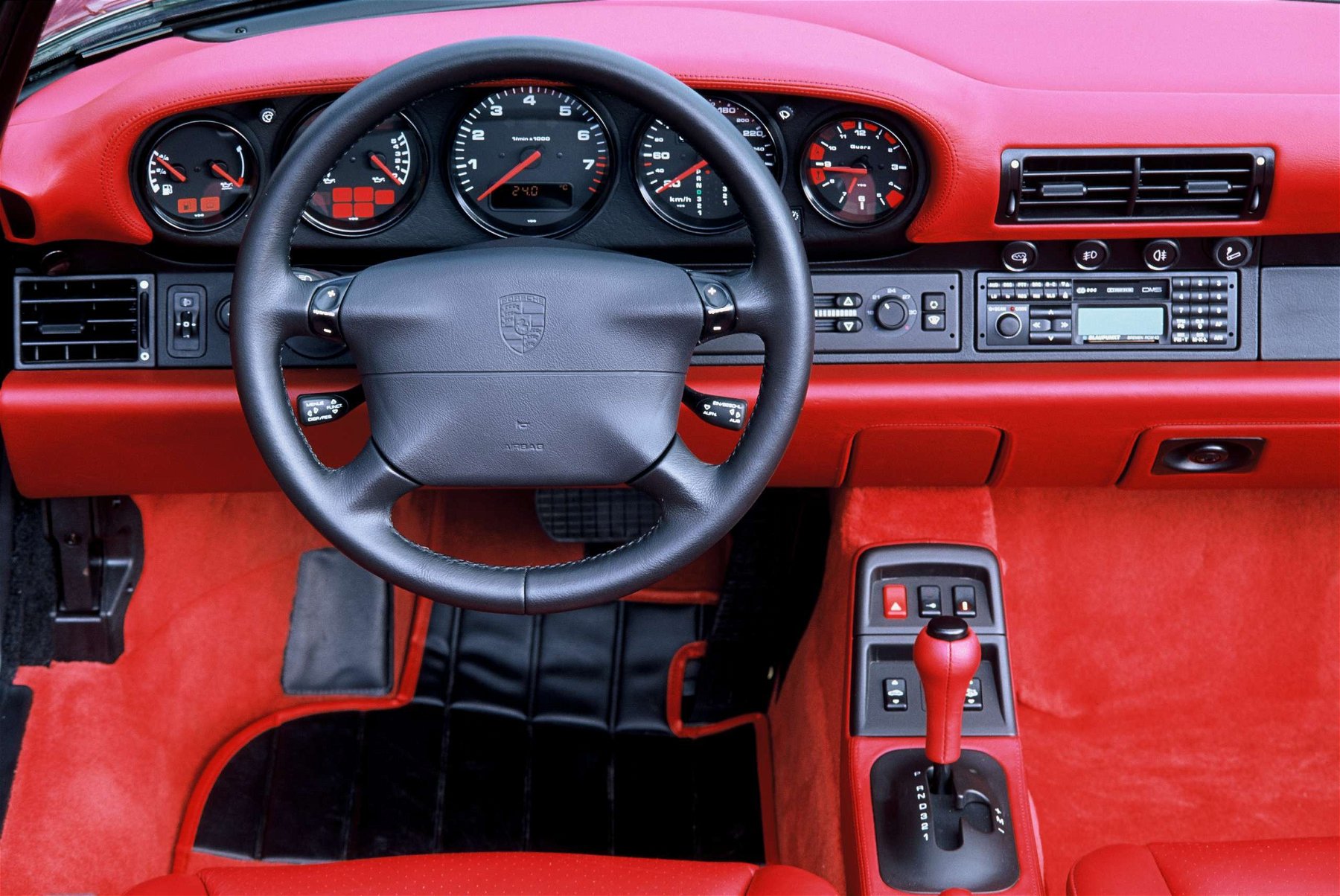
New models in the Porsche 993 series were eagerly awaited. And Porsche delivered just that with the 993 Turbo, 993 Carrera RS and 993 GT2. The Porsche 993 Turbo made the start. Its new, 3.6-liter bi-turbo engine (M64/60) produced 408 hp and not only helped offered outstanding driving performance. By using a newly developed emissions control system called Onboard Diagnostics II (OBD II) in a production vehicle for the first time, the turbo engine “turned out to be the lowest-emission production car engine in the world”.
The Porsche 993 Turbo also received the Carrera 4’s all-wheel drive system and, for the first time, a 6-speed manual transmission. To offer adequate stopping power, Porsche opted for 322 mm discs all around with red-painted brake calipers. Its fixed rear spoiler even received a design award in the “exterior applications” category with the SPE Automotive-Division Award in 1995. No wonder, then, that the 993 Turbo is considered by many to be one of the most beautiful Porsche models of all time. The 993 Turbo Cabriolet, on the other hand, based on the narrow Carrera-body and 964 Turbo 3.6 technology, is an absolute exception, with only 14 examples built.
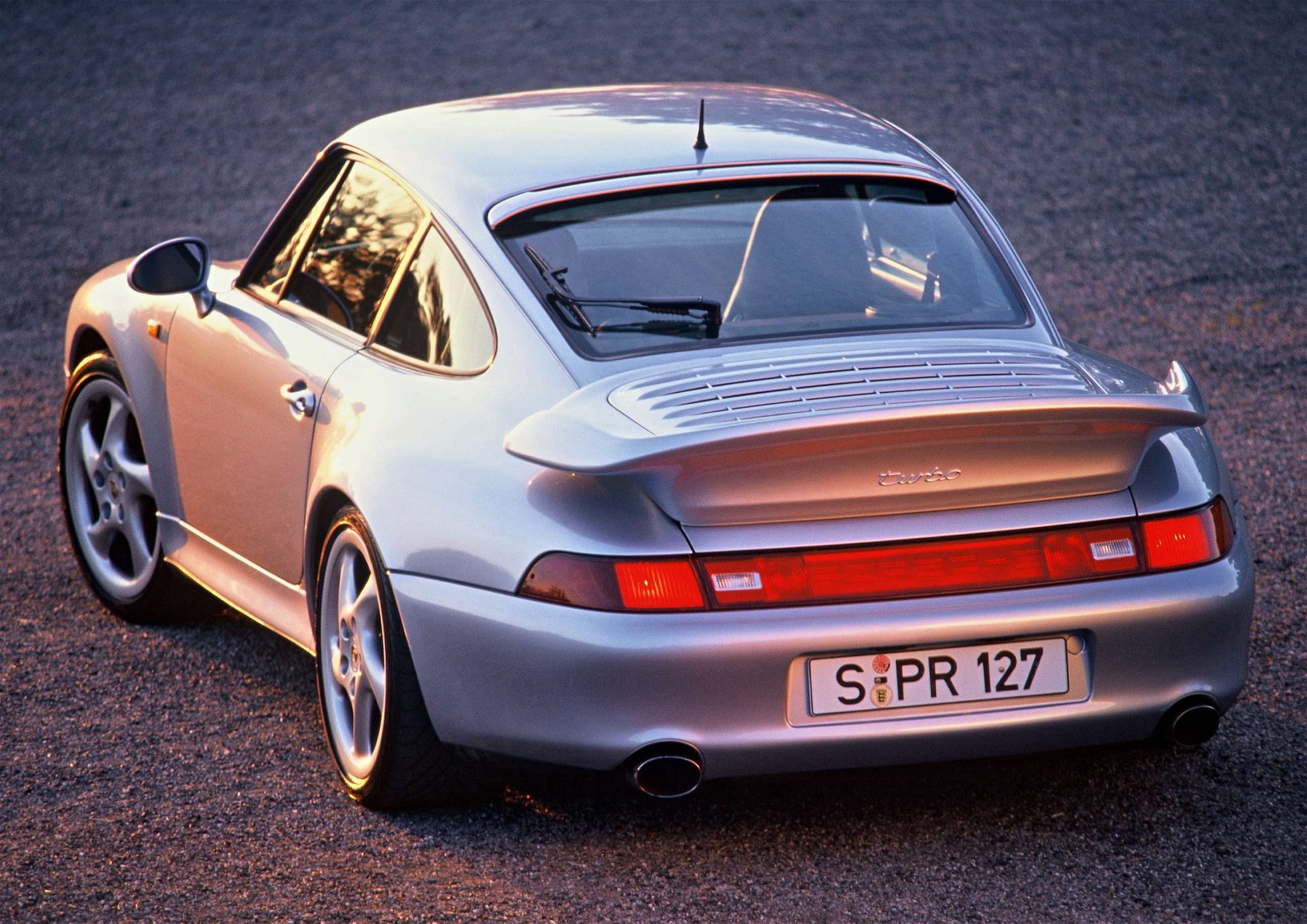


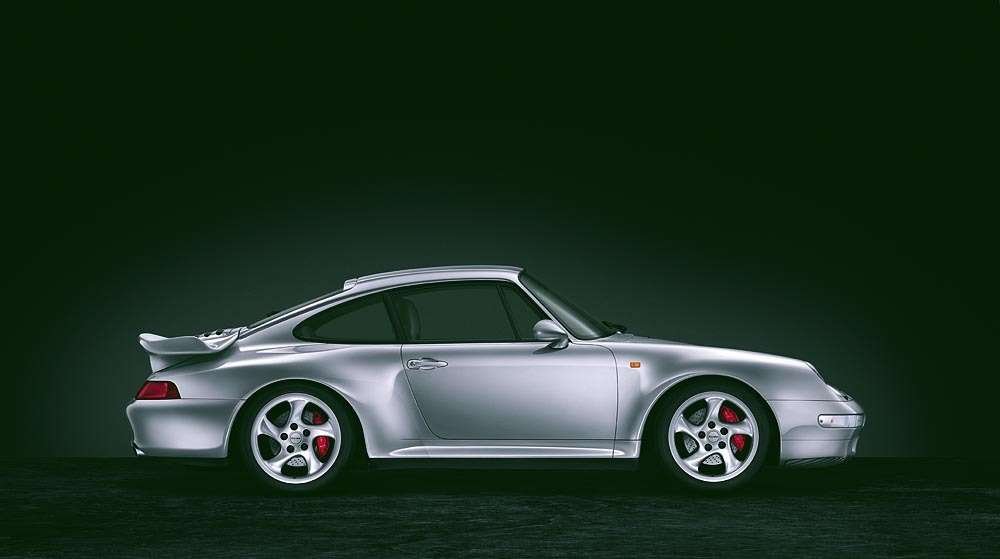
Like the two previous 911 generations, the Porsche 993 received a sports model with a naturally aspirated engine and low weight in the form of the Carrera RS. Thanks to the aluminum front hood, thin glass, and the elimination of the insulation, the Porsche 993 Carrera RS weighs in at a whopping 100 kilograms less than the Carrera.
Equipped with the new VarioRam system, i.e. variable intake funnels, the Rennsport 911 drew 300 hp from the 3.8-liter M64/20 powerplant and cost about DM 19,000 more than the Carrera. The optional Clubsport package with, including a shorter gearbox, roll cage, fire extinguisher, Nomex bucket seats and the omission of all carpets cost an additional DM 17,000.
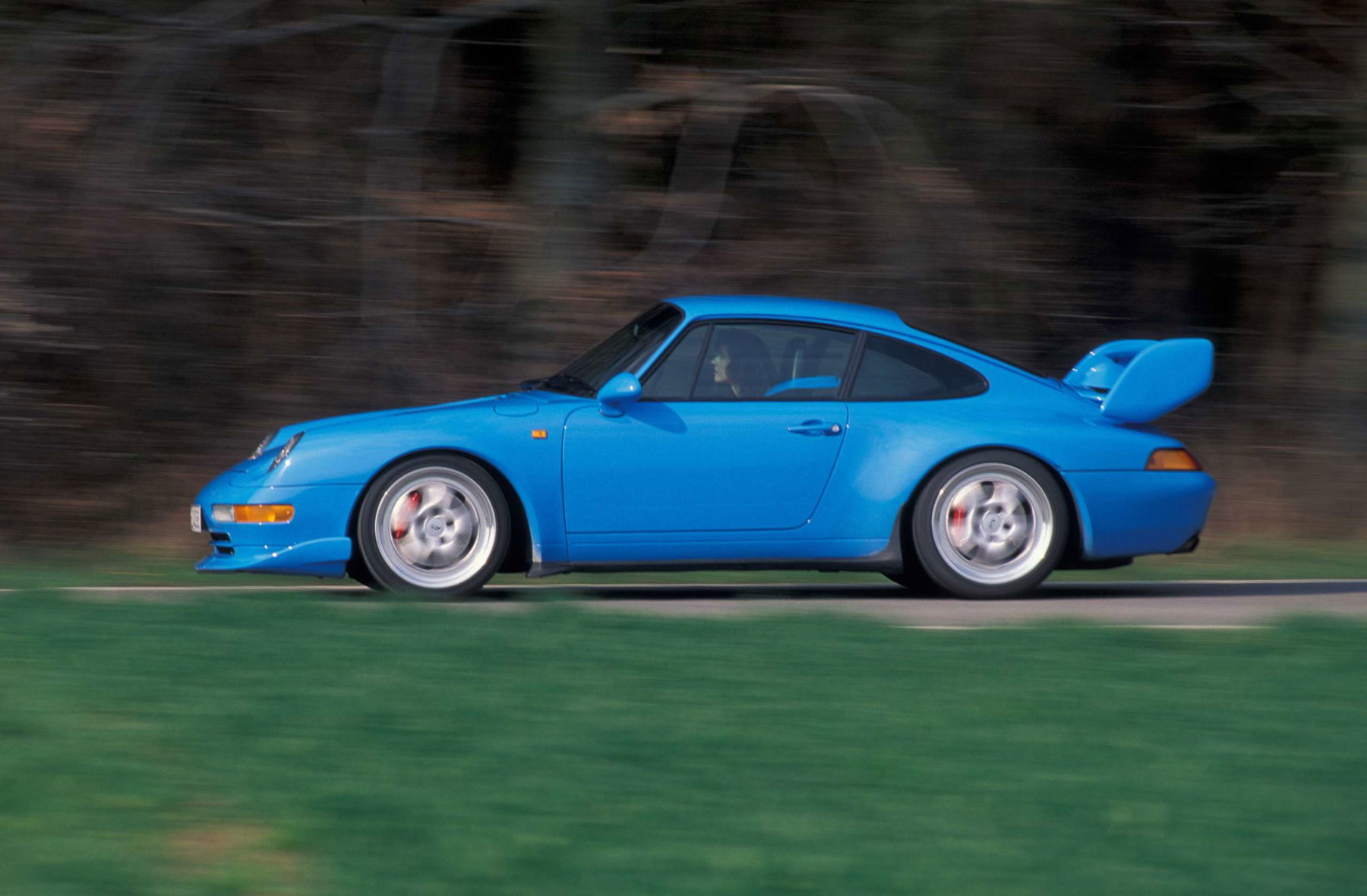
The holy grail, however, was the Porsche 993 GT2. It shared the technical basis with the 993 Turbo, which was introduced at the same time. However, the GT2 underwent a similar diet to the Carrera RS and also dispensed with the Turbo’s all-wheel drive. This reduced its weight by 200 kilograms to 1,295 kilograms.
The riveted fender extensions and the extreme rear fender with integrated air intakes were decidedly unusual for a production car. But as the most powerful production 911 of all time, the Porsche 993 GT2 could afford this. Compared to a total of 1,017 Porsche 993 Carrera RS, it is even rarer. Only 172 GT2s of the first development stage were built at prices starting at DM 268,000, which corresponded to two decently equipped 993 Carrera.
After two years, Porsche revised the 993 Carrera once again. The Carrera models received the VarioRam system from the Carrera RS. Larger valves also increased output in the M64/21 and M64/22 to 285 hp. Porsche Exclusive also offered the option of a power upgrade (equipment code X51) to 300 hp. In addition, the M64/21 S received, among other things, an increase in displacement to 3.8 liters.
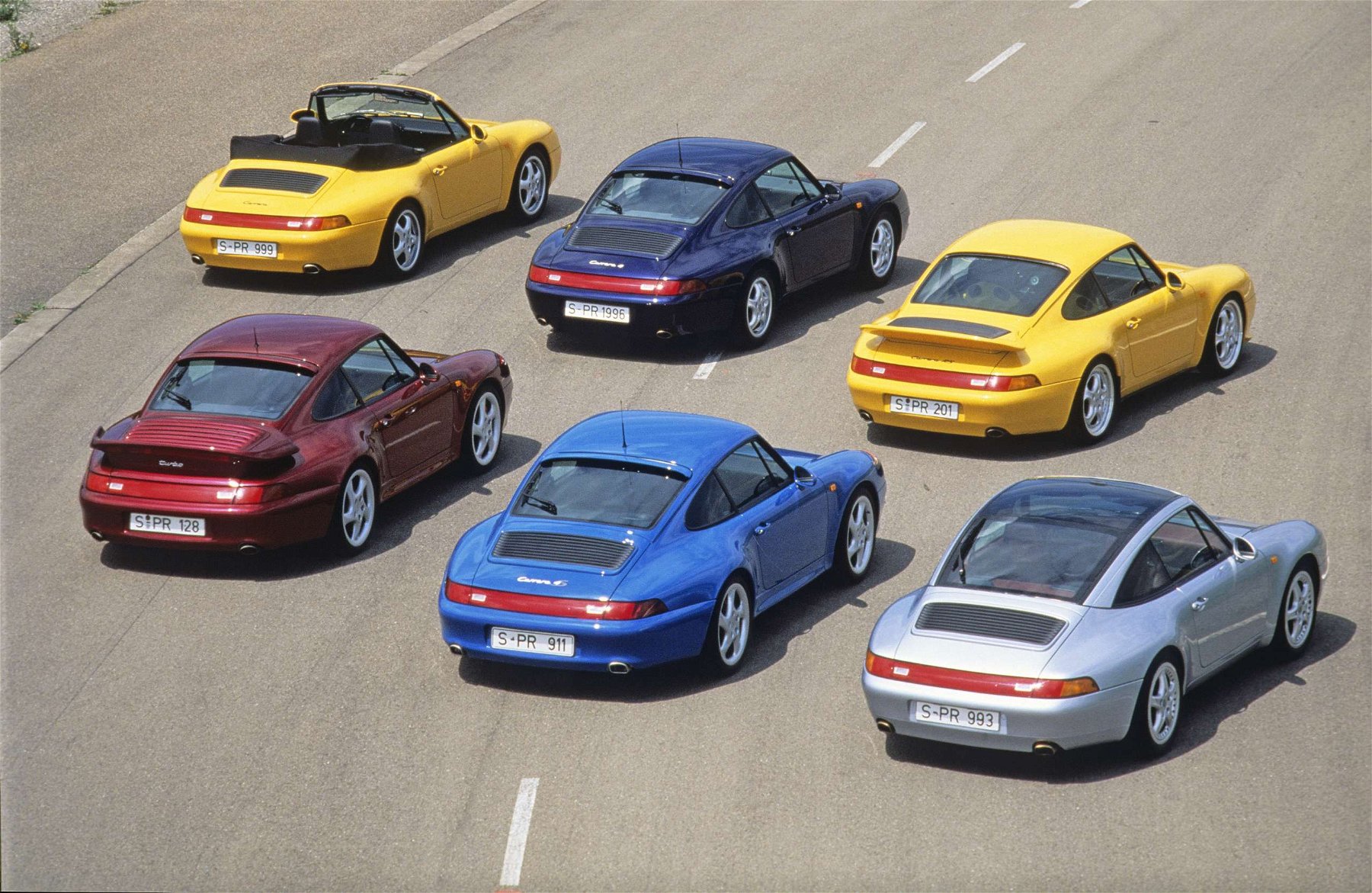
Central locking with radio remote control was now on board as standard, and various hands-free and cell phone devices were available. From the 1996 model year, the exhaust tailpipes were no longer oval, but in the form of a rounded trapezoid.
Porsche also presented two other variants of the 993 for the new model year. With the Porsche 993 Targa, the Stuttgart-based company broke with the tradition of the removable targa roof and instead offered an electrically opening glass roof and a strongly accentuated roofline. Technically, it corresponded to the 993 Carrera and was based on a slightly modified convertible body. The Targa was only available with rear-wheel drive.

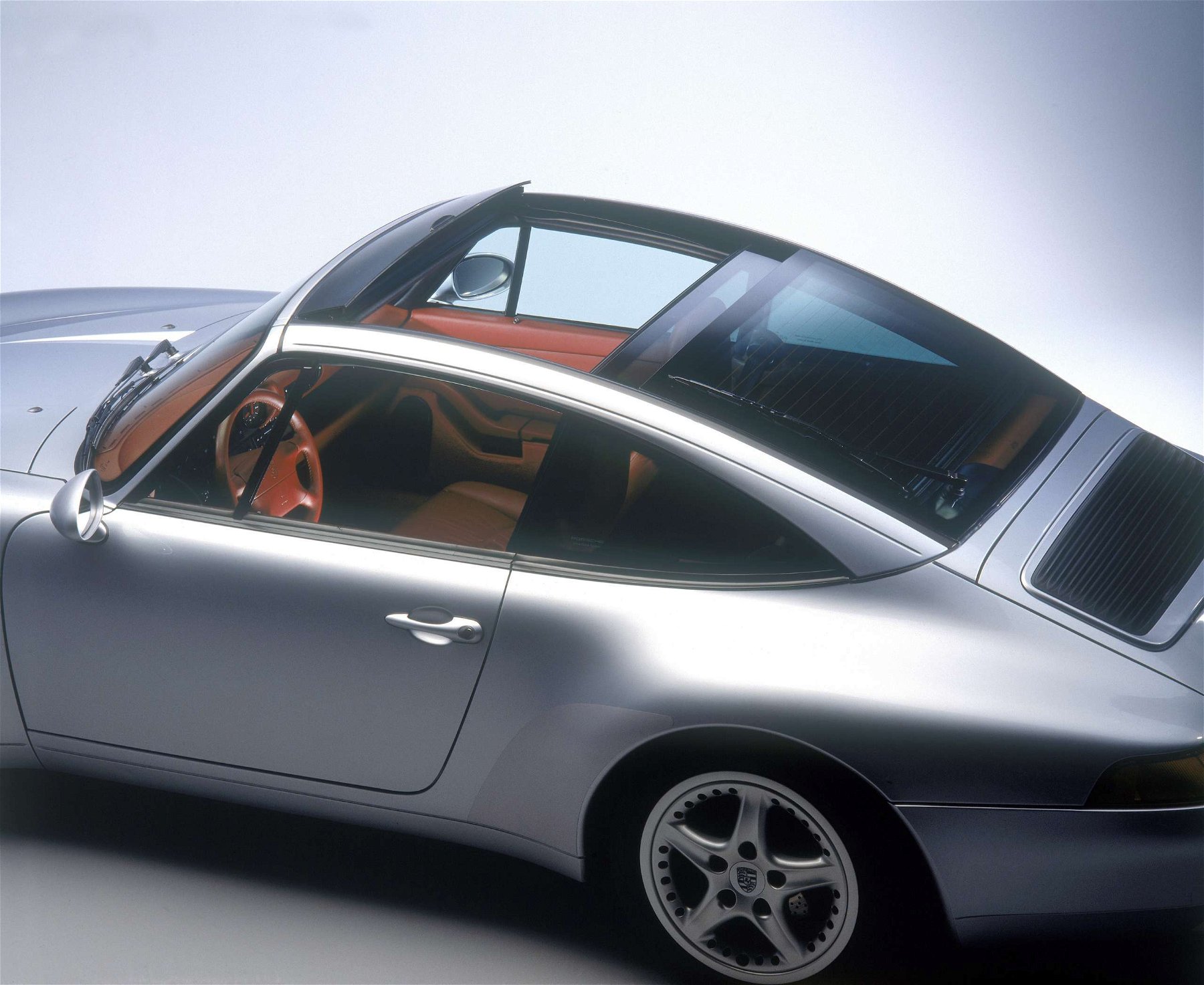
The second new 911 model of 1996 was the Porsche 993 Carrera 4S. This was in essence a 993 Carrera 4 with sports suspension and the wide body and brake system of the 993 Turbo. With electric seats, on-board computer and air conditioning, it was better equipped than the regular Carrera as standard. However, just like its other all-wheel-drive siblings, the 993 Carrera 4S was not available with a Tiptronic transmission.
For Ferdinand Alexander “Butzi” Porsche’s 60th birthday, the Exclusive department wanted to give the 911’s designer a special present. The idea of building a speedster quickly emerged. The engineers chose the Porsche 993 Carrera 2 Cabriolet as the basis. To create the body shape that has been inextricably linked with Porsche since the 1950s, they helped themselves to the predecessor’s parts rack. The windshield and trunk lid came from the Porsche 964 Speedster.

This dark green Speedster had brown leather on the inside and a Tiptronic transmission. Today it is in the Porsche Museum, where it is guarded like a raw egg. With the exception of a Speedster replicated in 2001 at the special request of U.S. actor Jerry Seinfeld, it is a solitaire. The Speedster never made it into mass production.
Porsche prepared to compete again in the highest class of the FIA GT World Championship from 1996. The regulations required at least one road-legal homologation model. Porsche therefore designed the 911 GT1 with the front end of the 993.
Underneath, there was a lot of technology from the Porsche Group C racer 962. Although the front end came from the 993 up to the B-pillar, a trellis frame was mounted behind it. A lot of know-how from the Group C was used there. Its water-cooled mid-engine had a displacement of 3.2 liters and produced 544 hp thanks to bi-turbo charging.
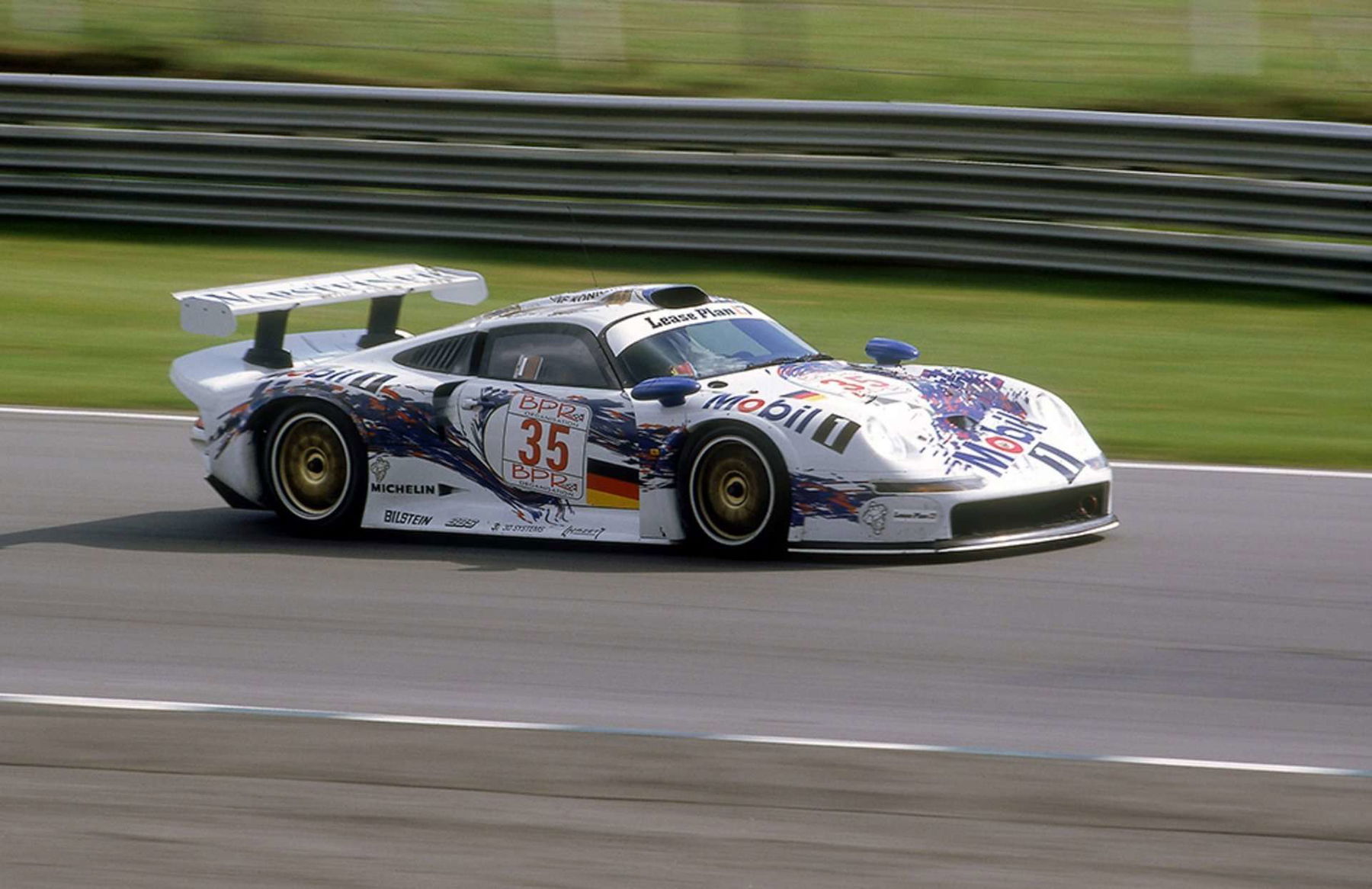
From model year 1996, there was also a factory performance upgrade for the Porsche 993 Turbo. The kit, called WLS I, tickled 22 additional horsepower out of the 3.6-liter bi-turbo engine and was available under the equipment code X50 both for new vehicles and as a retrofit kit.
While the Porsche 993 Carrera RS was removed from the model range, the 993 Carrera S was added as another model. There is usually talk that the Porsche 993 Carrera S was primarily launched to offer a Tiptronic Carrera with a turbo look.
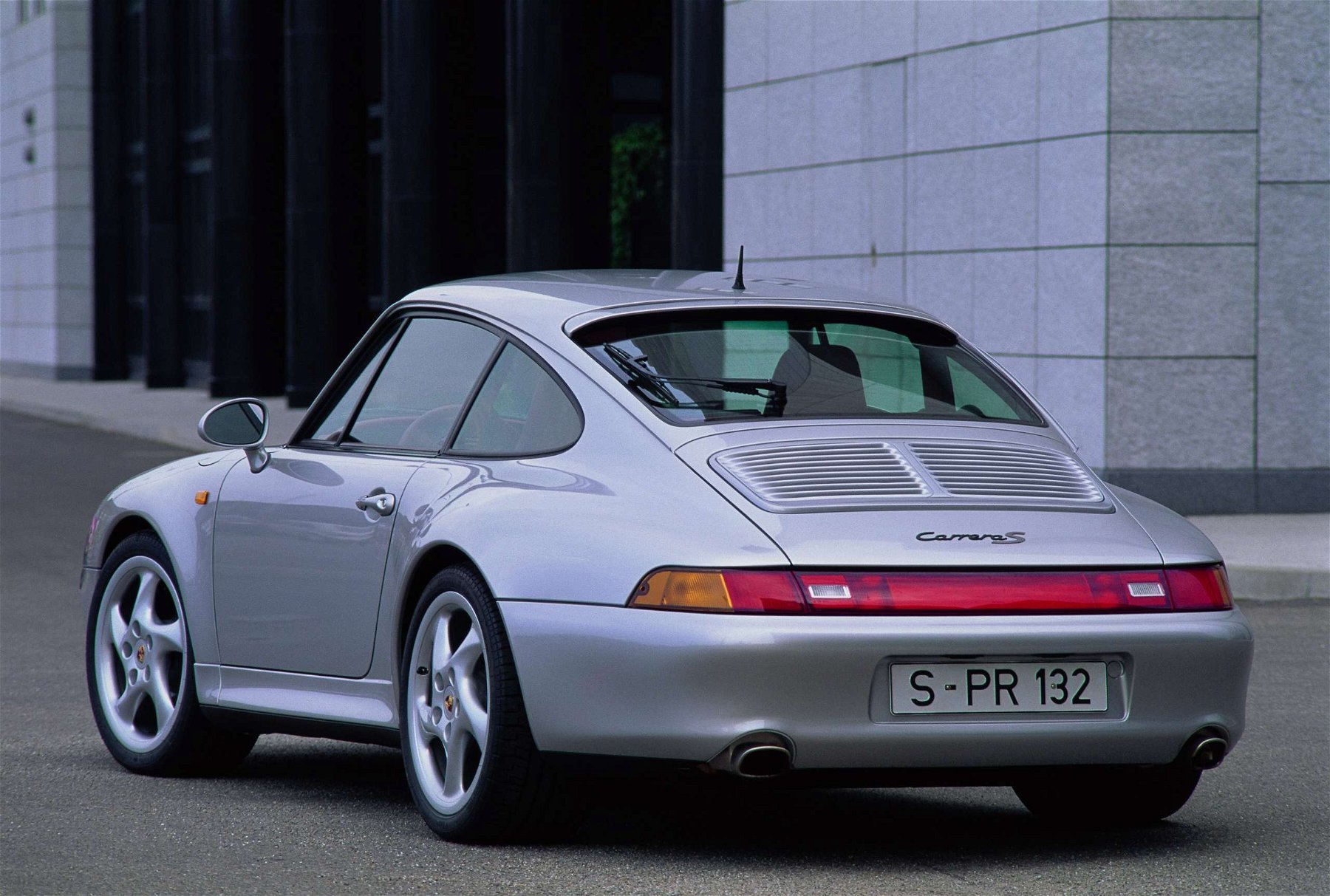

The primary visual distinguishing feature between the S and the 4S is the retractable spoiler on the engine cover. On the 4S, the air vents run continuously, whereas on the 993 Carrera S they are divided vertically in the center. Unlike the Carrera 4S, however, the rear-wheel-drive Carrera S had regular Carrera’s brake system.
1998 was a very special year for Porsche. On the one hand, sales of the first water-cooled 911, the Porsche 996, had already begun. So Porsche took the 993 Carrera and Carrera 4 models out of the program. However, parallel to the Porsche 996 Carrera, there were still 993 models on offer. The 993 Turbo, Targa and Carrera S/4S were produced along the 996.
But that was not all. The Porsche 993 GT2 received a performance upgrade to 450 hp. This was also offered to Turbo customers as WLS II. A sports suspension was also available as an option for the 993 Turbo during its last model year. With the 993 Turbo S, Porsche Exclusive also produced 345 cars with a 450 hp engine and Aerokit II. At first glance, it can be distinguished from the regular Turbo by the new spoiler and additional air intakes next to the front turn signals and in the rear fenders.
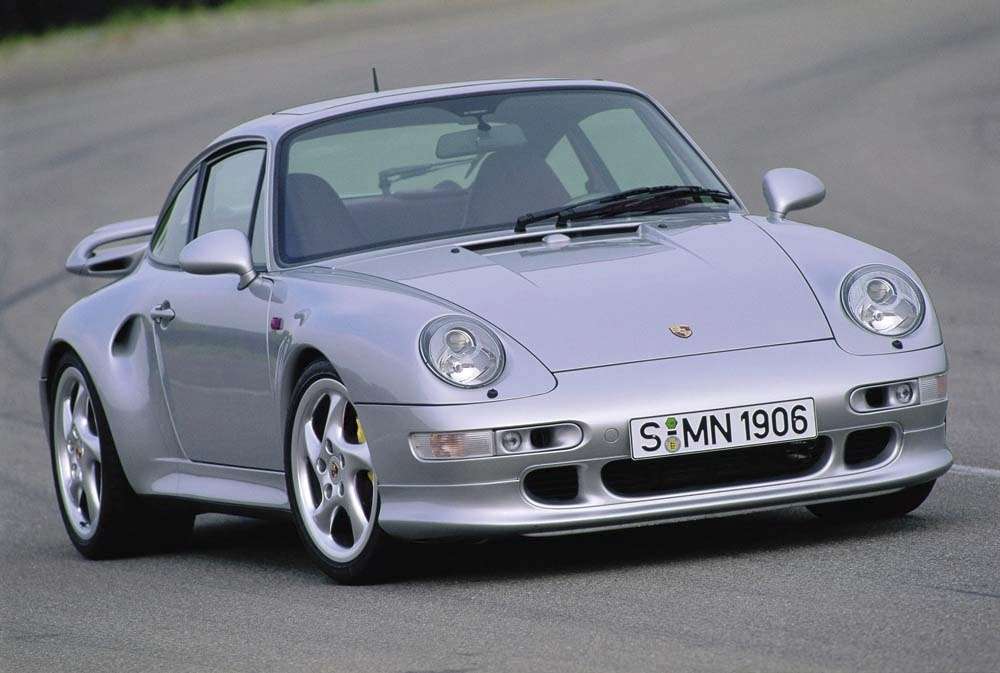
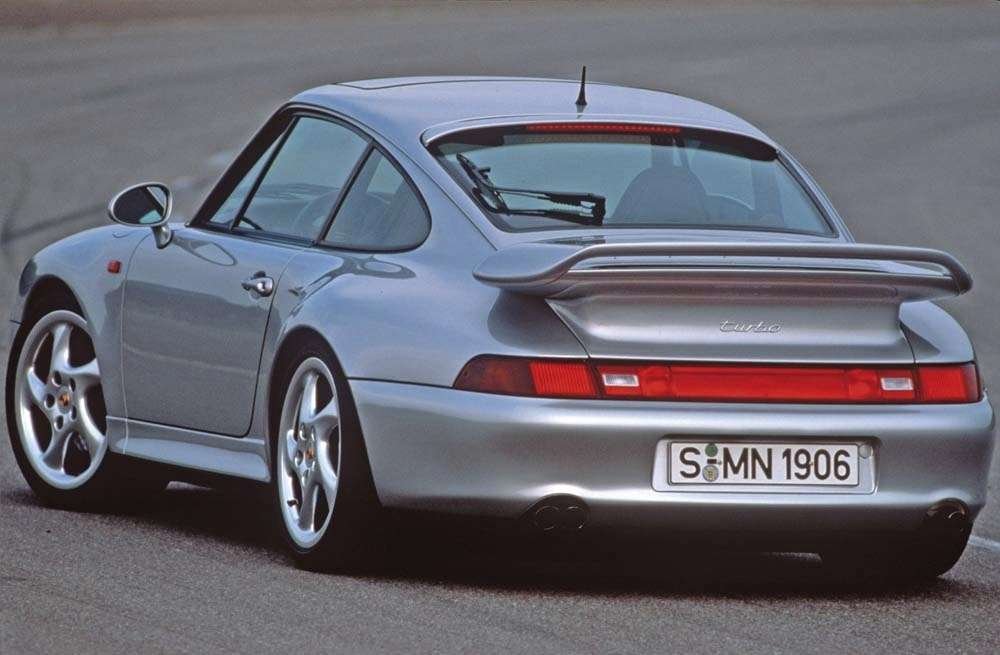
On March 27, 1998, Porsche completed the last air-cooled engine for a production Porsche. Tragically, Ferdinand Anton Ernst (Ferry) Porsche, the only son of company founder Ferdinand Porsche, died on the same day. On March 31, 1998, the last air-cooled Porsche finally rolled off the production line. That 911 Carrera 4S was bought by American actor and Porsche collector Jerry Seinfeld.
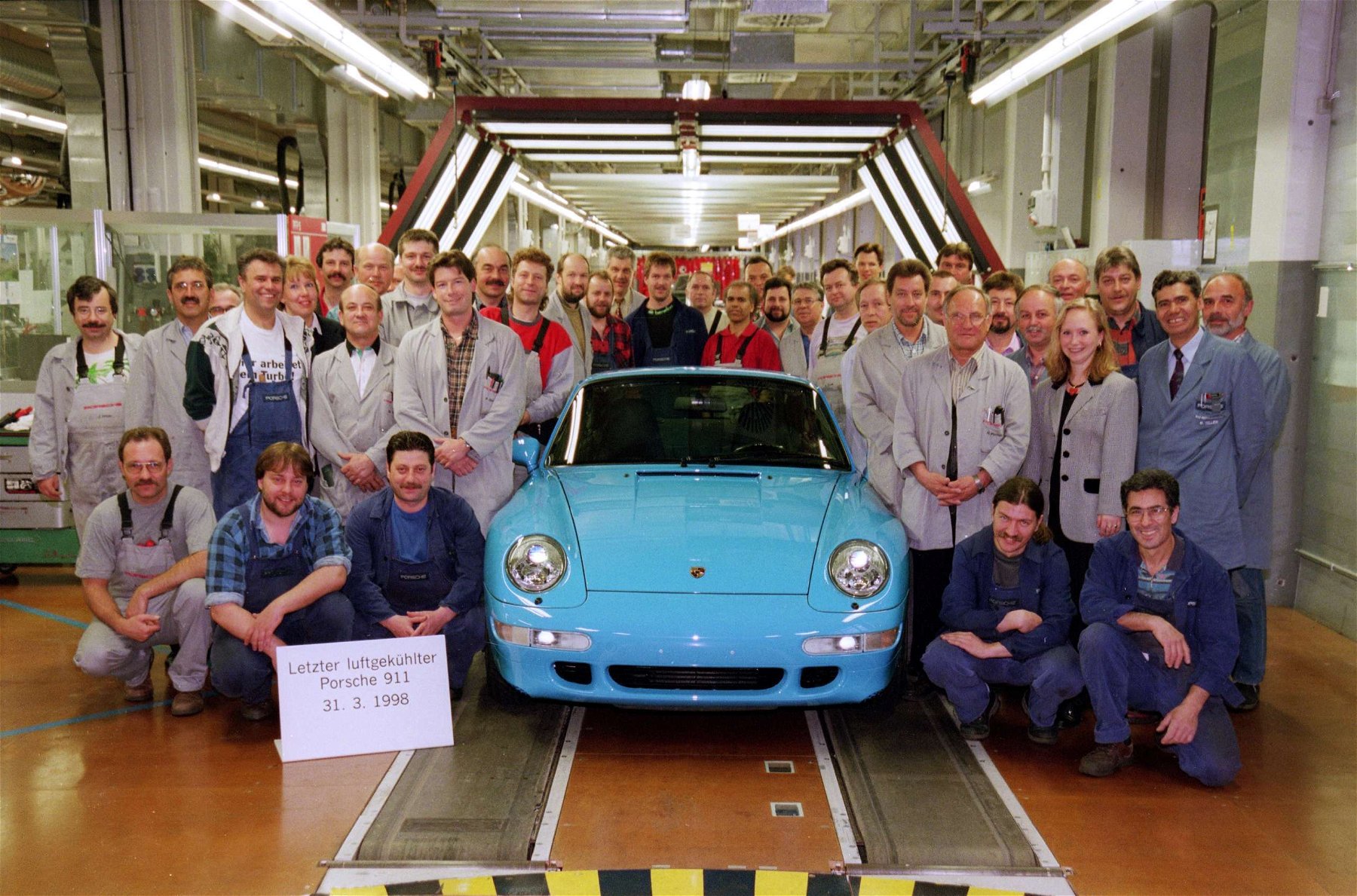
| model: | 993 Carrera MY 1994-1995 | 993 Carrera WLS und Motorsport Weissach MY 1994-1995 | 993 Carrera 4 MY 1995 | 993 Carrera MY 1996-1997 | 993 Carrera WLS MY 1996-1997 | 993 Carrera 4 MY 1996-1997 |
|---|---|---|---|---|---|---|
| model year: | 1994 - 1995 | 1994 - 1995 | 1995 | 1996 - 1997 | 1996 - 1997 | 1996 - 1997 |
| engine: | 6-cylinder boxer engine M64/05 [M64/06] | 6-cylinder boxer engine M64/05 S [M64/06 S] or M64/05 R | 6-cylinder boxer engine M64/05 | 6-cylinder boxer engine M64/21 [M64/22] | 6-cylinder boxer engine M64/21 S | 6-cylinder boxer engine M64/21 |
| capacity: | 3,600 cm³ | 3,746 cm³ | 3,600 cm³ | 3,600 cm³ | 3,746 cm³ | 3,600 cm³ |
| bore x stroke: | 100 × 76.4 mm | 102 × 76.4 mm | 100 × 76.4 mm | 100 × 76.4 mm | 102 × 76.4 mm | 100 × 76.4 mm |
| power: | 200 kW (272 hp) at 6,100 rpm | 210 kW (285 hp) at 6,000 rpm or 220 kW (299 hp) at 6,100 rpm | 200 kW (272 hp) at 6,100 rpm | 210 kW (285 hp) at 6,100 rpm | 221 kW (300 hp) at 6,600 rpm | 210 kW (285 hp) at 6,100 rpm |
| torque: | 330 Nm at 5,000 rpm | 350 Nm at 5,000 rpm or 365 Nm at 5,250 rpm | 330 Nm at 5,000 rpm | 340 Nm at 5,250 rpm | 355 Nm at 5,400 rpm | 340 Nm at 5,250 rpm |
| compression ratio: | 11.3 : 1 | 11.3 : 1 | 11.3 : 1 | 11.3 : 1 | 11.3 : 1 | 11.3 : 1 |
| valvetrain: | single overhead camshaft (SOHC) | single overhead camshaft (SOHC) | single overhead camshaft (SOHC) | single overhead camshaft (SOHC) | single overhead camshaft (SOHC) | single overhead camshaft (SOHC) |
| fuel injection: | manifold injection Bosch DME Motronic 2.10 | manifold injection Bosch DME Motronic 2.10 | manifold injection Bosch DME Motronic 2.10 | manifold injection Bosch DME Motronic 5.2 | manifold injection Bosch DME Motronic 5.2 | manifold injection Bosch DME Motronic 5.2 |
| ignition: | contactless double ignition | contactless double ignition | contactless double ignition | contactless double ignition | contactless double ignition | contactless double ignition |
| cooling: | air-cooling | air-cooling | air-cooling | air-cooling | air-cooling | air-cooling |
| gearbox: | 6-speed manual G50/21 or 4-speed tiptronic A50/04 | 6-speed manual G50/21 or 4-speed tiptronic A50/04 (Weissach only with manual) | 6-speed manual G64/21 | 6-speed manual G50/21 or 4-speed tiptronic S A50/04 | 6-speed manual G50/21 | 6-speed manual G50/21 |
| drive: | rear wheel drive | rear wheel drive | rear wheel drive | rear wheel drive | rear wheel drive | rear wheel drive |
| brakes: | ventilated, drilled disc brakes (304/299 mm), 4-piston fixed calipers | ventilated, drilled disc brakes (304/299 mm), 4-piston fixed calipers | ventilated, drilled disc brakes (304/299 mm), 4-piston fixed calipers | ventilated, drilled disc brakes (304/299 mm), 4-piston fixed calipers | ventilated, drilled disc brakes (304/299 mm), 4-piston fixed calipers | ventilated, drilled disc brakes (304/299 mm), 4-piston fixed calipers |
| front suspension: | MacPherson struts, with wishbone and anti-roll-bar | MacPherson struts, with wishbone and anti-roll-bar | MacPherson struts, with wishbone and anti-roll-bar | MacPherson struts, with wishbone and anti-roll-bar | MacPherson struts, with wishbone and anti-roll-bar | MacPherson struts, with wishbone and anti-roll-bar |
| rear suspenion: | multi link rear axle with LSA-System (lightweigt, stability, agility), subframe and anti-roll-bar | multi link rear axle with LSA-System (lightweigt, stability,- Agilität), subframe and anti-roll-bar | multi link rear axle with LSA-System (lightweigt, stability,- Agilität), subframe and anti-roll-bar | multi link rear axle with LSA-System (lightweigt, stability,- Agilität), subframe and anti-roll-bar | multi link rear axle with LSA-System (lightweigt, stability,- Agilität), subframe and anti-roll-bar | multi link rear axle with LSA-System (lightweigt, stability,- Agilität), subframe and anti-roll-bar |
| front spring setup: | struts with gas shocks | struts with gas shocks | struts with gas shocks | struts with gas shocks | struts with gas shocks | struts with gas shocks |
| rear spring setup: | struts with gas shocks | struts with gas shocks | struts with gas shocks | struts with gas shocks | struts with gas shocks | struts with gas shocks |
| track width: | 1405/1444 mm | 1405/1444 mm | 1405/1444 mm | 1405/1444 mm | 1405/1444 mm | 1405/1444 mm |
| wheelbase: | 2272 mm | 2272 mm | 2272 mm | 2272 mm | 2272 mm | 2272 mm |
| wheels: | 7 J x 16 / 9 J x 16 or 7 J x 17 / 9 J x 17 | 7 J x 16 / 9 J x 16 or 7 J x 17 / 9 J x 17 | 7 J x 17 / 9 J x 17 | 7 J x 16 / 9 J x 16 or 7 J x 17 / 9 J x 17 | 7 J x 17 / 9 J x 17 | 7 J x 16 / 9 J x 16 or 7 J x 17 / 9 J x 17 |
| tyres: | 205/55 / 245/45 ZR16 205/50 / 255/40 ZR17 | 205/55 / 245/45 ZR16 205/50 / 255/40 ZR17 | 205/50 / 255/40 ZR17 | 205/55 / 245/45 ZR16 205/50 / 255/40 ZR17 | 205/50 / 255/40 ZR17 | 205/55 / 245/45 ZR16 205/50 / 255/40 ZR17 |
| dimensions l x w x h: | 4245 x 1735 x 1300 mm (with sports suspension 1285 mm) | 4245 x 1735 x 1300 mm (with sports suspension 1285 mm) | 4245 x 1735 x 1300 mm (with sports suspension 1285 mm) | 4245 x 1735 x 1300 mm (with sports suspension 1285 mm) | 4245 x 1735 x 1300 mm (with sports suspension 1285 mm) | 4245 x 1735 x 1300 mm (with sports suspension 1285 mm) |
| kurb weight: | 1,370 kg [1,395 kg] | 1,370 kg [1,395 kg] | 1,420 kg | 1,370 kg [1,395 kg] | 1,370 kg | 1,420 kg |
| top speed: | 270 kph [265 kph] | 270 kph [265 kph] or 280 kph | 270 kph | 275 kph [270 kph] | >275 kph | 275 kph |
| accleration 0 - 62 mph: | 5.6 s [6.6 s] | 5.6 s [6.6 s] or 5.2 s | 5.6 s | 5.4 s [6.4 s] | <5.4 s | 5.3 s |
| production numbers: | Coupé: 14,541 Cabrio: 7,730 | Coupé: 2,884 Cabrio: 1,284 | Coupé: 8,586 Cabrio: 7,769 | Coupé: 1,860 Cabrio: 1,138 |
||

| model: | 993 Carrera S | 993 Carrera 4S | 993 Carrera RS | 993 Targa |
|---|---|---|---|---|
| model year: | 1997 - 1998 | 1996 - 1998 | 1995 - 1996 | 1996 - 1997 |
| engine: | 6-cylinder boxer engine M64/21 [M64/22] | 6-cylinder boxer engine M64/21 | 6-cylinder boxer engine M64/20 | 6-cylinder boxer engine M64/21 [M64/22] |
| capacity: | 3,600 cm³ | 3,600 cm³ | 3,746 cm³ | 3,600 cm³ |
| bore x stroke: | 100 × 76.4 mm | 100 × 76.4 mm | 102 × 76.4 mm | 100 × 76.4 mm |
| power: | 210 kW (285 hp) at 6,100 rpm | 210 kW (285 hp) at 6,100 rpm | 221 kW (300 hp) at 6,600 rpm | 210 kW (285 hp) at 6,100 rpm |
| torque: | 340 Nm at 5,250 rpm | 340 Nm at 5,250 rpm | 355 Nm at 5,400 rpm | 340 Nm at 5,250 rpm |
| compression ratio: | 11.3 : 1 | 11.3 : 1 | 11.3 : 1 | 11.3 : 1 |
| valvetrain: | single overhead camshaft (SOHC) | single overhead camshaft (SOHC) | single overhead camshaft (SOHC) | single overhead camshaft (SOHC) |
| fuel injection: | manifold injection Bosch DME Motronic 5.2 | manifold injection Bosch DME Motronic 5.2 | manifold injection Bosch DME Motronic 2.10 | manifold injection Bosch DME Motronic 5.2 |
| ignition: | contactless double ignition | contactless double ignition | contactless double ignition | contactless double ignition |
| cooling: | air-cooling | air-cooling | air-cooling | air-cooling |
| gearbox: | 6-speed manual G50/20 or 4-speed Tiptronic S A50/04 | 6-speed manual G50/21 | 6-speed manual G50/31 or G50/32 | 6-speed manual G50/21 or 4-speed Tiptronic S A50/04 |
| drive: | rear-wheel-drive | rear-wheel-drive | rear-wheel-drive | rear-wheel-drive |
| brakes: | ventilated, drilled disc brakes (304/299 mm), 4-piston fixed calipers | ventilated, drilled disc brakes (322/322 mm), 4-piston fixed calipers | ventilated, drilled disc brakes (322/322 mm), 4-piston fixed calipers | ventilated, drilled disc brakes (304/299 mm), 4-piston fixed calipers |
| front suspension: | MacPherson struts, with wishbone and anti-roll-bar | MacPherson struts, with wishbone and anti-roll-bar | MacPherson struts, with wishbone and anti-roll-bar | MacPherson struts, with wishbone and anti-roll-bar |
| rear suspenion: | multi link rear axle with LSA-System (lightweigt, stability, agility), subframe and anti-roll-bar | multi link rear axle with LSA-System (lightweigt, stability,- Agilität), subframe and anti-roll-bar | multi link rear axle with LSA-System (lightweigt, stability,- Agilität), subframe and anti-roll-bar | multi link rear axle with LSA-System (lightweigt, stability,- Agilität), subframe and anti-roll-bar |
| front spring setup: | struts with gas shocks | struts with gas shocks | struts with gas shocks | struts with gas shocks |
| rear spring setup: | struts with gas shocks | struts with gas shocks | struts with gas shocks | struts with gas shocks |
| track width: | 1405/1536 mm | 1411/1504 mm | 1413/1452 mm | 1405/1444 mm |
| wheelbase: | 2272 mm | 2272 mm | 2272 mm | 2272 mm |
| wheels: | 7 J x 17 / 9 J x 17 or 8 J x 18 / 10 J x 18 | 8 J x 18 / 10 J x 18 | 8 J x 18 / 10 J x 18 | 7 J x 17 / 9 J x 17 |
| tyres: | 205/50 / 255/40 ZR17 225/40 / 285/30 ZR18 | 225/40 / 285/30 ZR18 | 225/40 / 265/35 ZR18 | 205/50 / 255/40 ZR17 |
| dimensions l x w x h: | 4245 x 1795 x 1285 mm | 4245 x 1795 x 1285 mm | 4245 x 1735 x 1270 mm | 4245 x 1735 x 1300 mm (with sports suspension 1285 mm) |
| kurb weight: | 1,400 kg [1,425 kg] | 1,450 kg | 1,270 kg | 1,400 kg [1,425 kg] |
| top speed: | 270 kph [265 kph] | 270 kph | 277 kph | 275 kph [270 kph] |
| accleration 0 - 62 mph: | 5.4 s [6.4 s] | 5.3 s | 5.0 s | 5.4 s [6.4 s] |
| production numbers: | 3,714 | 6,948 | 1,014, incl, 227 Clubsport | 4,583 |
| model: | 993 Turbo | 993 Turbo Cabrio | 993 Turbo WLS | 993 Turbo WLS 2 | 993 Turbo S | 993 GT2 |
|---|---|---|---|---|---|---|
| model year: | 1995 - 1998 | 1995 | 1996 - 1998 | 1998 | 1998 | 1995 - 1997 |
| engine: | 6-cylinder boxer engine M64/60 | 6-cylinder boxer engine M64/50 | 6-cylinder boxer engine M64/60 R | 6-cylinder boxer engine M64/60 RS | 6-cylinder boxer engine M64/60 S | 6-cylinder boxer engine M64/60 S |
| capacity: | 3.600 cm³ | 3.600 cm³ | 3.600 cm³ | 3.600 cm³ | 3.600 cm³ | 3.600 cm³ |
| bore x stroke: | 100 × 76.4 mm | 100 × 76.4 mm | 100 × 76.4 mm | 100 × 76.4 mm | 100 × 76.4 mm | 100 × 76.4 mm |
| power: | 300 kW (408 hp) bei 5.750 rpm | 265 kW (360 hp) bei 5.500 rpm | 316 kW (430 hp) bei 5.750 rpm | 331 kW (450 hp) bei 6.000 rpm | 331 kW (450 hp) bei 6.000 rpm | 331 kW (450 hp) bei 6.000 rpm |
| torque: | 540 Nm bei 4.500 rpm | 520 Nm bei 4.200 rpm | 540 Nm bei 4.500 rpm | 585 Nm bei 4.500 rpm | 585 Nm bei 4.500 rpm | 585 Nm bei 4.500 rpm |
| compression ratio: | 8.0 : 1 | 7.5 : 1 | 8.0 : 1 | 8.0 : 1 | 8.0 : 1 | 8.0 : 1 |
| valvetrain: | single overhead camshaft (SOHC) | single overhead camshaft (SOHC) | single overhead camshaft (SOHC) | single overhead camshaft (SOHC) | single overhead camshaft (SOHC) | single overhead camshaft (SOHC) |
| fuel injection: | manifold injection Bosch DME Motronic 5.2 | manifold injection Bosch K-Jetronic | manifold injection Bosch DME Motronic 5.2 | manifold injection Bosch DME Motronic 5.2 | manifold injection Bosch DME Motronic 5.2 | manifold injection Bosch DME Motronic 5.2 |
| ignition: | contactless single ignition | contatless single ignition | contactless single ignition | contactless single ignition | contactless single ignition | contactless single ignition |
| cooling: | air-cooling | air-cooling | air-cooling | air-cooling | air-cooling | air-cooling |
| gearbox: | 6-speed manual G64/51 | 6-speed manual G50/52 | 6-speed manual G64/51 | 6-speed manual G64/51 | 6-speed manual G64/51 | 6-speed manual G64/51 |
| drive: | all-wheel-drive | rear-wheel-drive | all-wheel-drive | all-wheel-drive | all-wheel-drive | rear-wheel-drive |
| brakes: | ventilated. drilled disc brakes (322/322 mm). 4-piston fixed calipers | ventilated. drilled disc brakes (322/299 mm). 4-piston fixed calipers | ventilated. drilled disc brakes (322/322 mm). 4-piston fixed calipers | ventilated. drilled disc brakes (322/322 mm). 4-piston fixed calipers | ventilated. drilled disc brakes (322/322 mm). 4-piston fixed calipers | ventilated. drilled disc brakes (322/322 mm). 4-piston fixed calipers |
| front suspension: | MacPherson struts. with wishbone and anti-roll-bar | MacPherson struts. with wishbone and anti-roll-bar | MacPherson struts. with wishbone and anti-roll-bar | MacPherson struts. with wishbone and anti-roll-bar | MacPherson struts. with wishbone and anti-roll-bar | MacPherson struts. with wishbone and anti-roll-bar |
| rear suspenion: | multi link rear axle with LSA-System (lightweigt. stability. agility). subframe and anti-roll-bar | multi link rear axle with LSA-System (lightweigt. stability.- Agilität). subframe and anti-roll-bar | multi link rear axle with LSA-System (lightweigt. stability.- Agilität). subframe and anti-roll-bar | multi link rear axle with LSA-System (lightweigt. stability.- Agilität). subframe and anti-roll-bar | multi link rear axle with LSA-System (lightweigt. stability.- Agilität). subframe and anti-roll-bar | multi link rear axle with LSA-System (lightweigt. stability.- Agilität). subframe and anti-roll-bar |
| front spring setup: | struts with gas shocks | struts with gas shocks | struts with gas shocks | struts with gas shocks | struts with gas shocks | struts with gas shocks |
| rear spring setup: | struts with gas shocks | struts with gas shocks | struts with gas shocks | struts with gas shocks | struts with gas shocks | struts with gas shocks |
| track width: | 1411/1504 mm | 1405/1444 mm | 1411/1504 mm | 1411/1504 mm | 1411/1504 mm | 1475/1550 mm |
| wheelbase: | 2272 mm | 2272 mm | 2272 mm | 2272 mm | 2272 mm | 2272 mm |
| wheels: | 8 J x 18 / 10 J x 18 | 7 J x 17 / 9 J x 17 | 8 J x 18 / 10 J x 18 | 8 J x 18 / 10 J x 18 | 8 J x 18 / 10 J x 18 | 8 J x 18 / 10 J x 18 |
| tyres: | 225/40 / 285/30 ZR18 | 205/50 / 255/40 ZR17 | 225/40 / 285/30 ZR18 | 225/40 / 285/30 ZR18 | 225/40 / 285/30 ZR18 | 225/40 / 285/30 ZR18 |
| dimensions l x w x h: | 4245 x 1795 x 1285 mm | 4245 x 1735 x 1300 mm | 4245 x 1795 x 1285 mm | 4245 x 1795 x 1285 mm | 4245 x 1795 x 1285 mm | 4245 x 1855 x 1270 mm |
| kurb weight: | 1.500 kg | 1.395 kg | 1.500 kg | 1.500 kg | 1.500 kg | 1.295 kg |
| top speed: | 290 kph | 280 kph | 297 kph | 300 kph | 300 kph | 300 kph |
| accleration 0 - 62 mph: | 4.5 s | 4.6 s | 4.3 s | 4.1 s | 4.1 s | <4.4 s |
| production numbers: | 5,978 | 14 | 345 | 21 |

After the Porsche Carrera Cup and Supercup’s groundbreaking success based on the Porsche 964, it was clear that a one-make cup based on the 993 should also be created. For the 1994 Porsche Supercup season, Porsche introduced the 911 3.8 Cup. The new Cup racer’s engine was largely similar to the 964 Carrera RS 3.8 unit. With its 310 hp it offered a whopping increase of 35 hp to 1993’s Cup car. Incidentally, in its first year of use, the 993 still started out with the rear spoiler that automatically extended at 80 km/h.
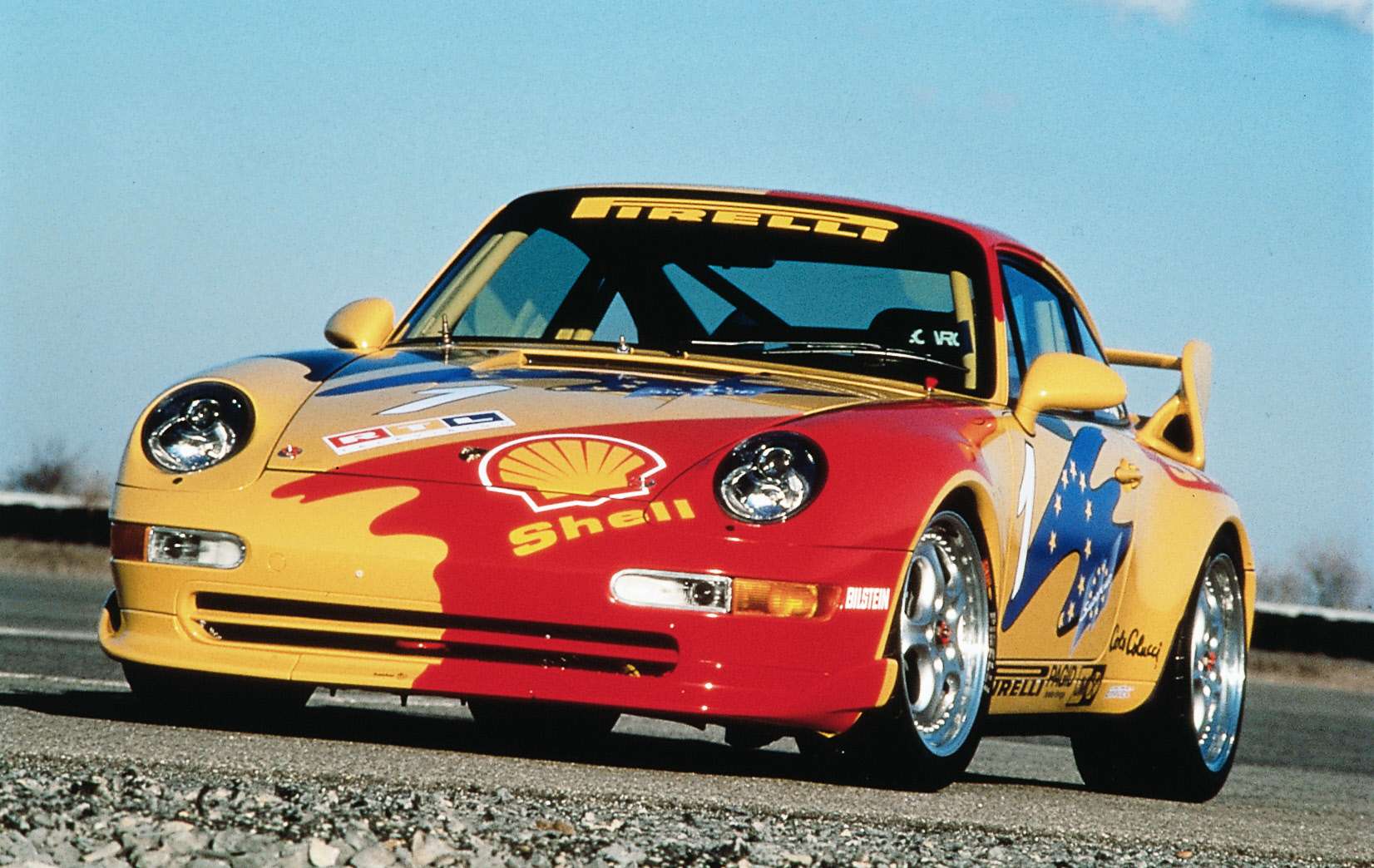

The development team headed by Roland Kußmaul intensively revised the chassis in particular. Its multi-link rear suspension had already come very close to a double wishbone design at that time. This made the Cup car more predictable to drive. Depending on the race track, it was several seconds faster than its predecessor as well. From 1995, the Carrera Cup also started with the new model. In addition, the rear spoiler, the Carrera RS’ front bumper and side skirts were used. In 1996, Porsche increased the power output to 315 hp. A total of 216 Porsche 993 Cup cars were produced at prices from DM 173,000.
The car is 70 mm lower than its production counterpart, the spring rate is twice as hard as in last year’s Cup car, and in collaboration with Pirelli we have achieved handling that even the most spoiled racers praise as sensational.
Roland Kußmaul about the Porsche 911 3.8 Cup (993)
Between 1996 and 1998, Porsche also offered a racing car for the GT3 classes with a naturally aspirated engine. The officially 325 hp Porsche 993 Cup 3.8 RSRs were primarily used in national GT3 categories, such as the Nürburgring Endurance Championship (VLN) and IMSA. Although RSRs were still in use until 2001, the production figure of only 15 and the few successes clearly show that the focus was on other projects.
In 1995, Porsche developed the 993 GT2 R to compete in the prestigious BPR Global GT Series. That was the legitimate successor series to the World Sports Car Championship. Based on the Porsche 993 Turbo, the result was a bi-turbo race car with 450 hp and a curb weight of 1,150 kilograms. Despite the superiority of the McLaren F1, the 993 GT2 R still managed to finish second overall in its first racing season. In the 1,000 kilometer race in Montlhéry, France, the Porsche 993 GT2 R even managed a triple victory, although the 911 was nominally only classified in the third-fastest category.
In the 1996 season, the Porsche 993 GT2 R still managed eight class victories the BPR Global GT Series. A total of 71 Porsche 993 GT2 R cars were produced and delivered to customer teams. Prices started at DM 345,000.
Porsche offered another eight 993 GT2 Evos for 1996 with once again increased performance. The pinnacle of air-cooled engines was produced only eight times. There were five 550 hp cars and three with 600 hp. However, it failed to meet expectations. so the 911 GT1 became the focus of attention. With it, Porsche won in all three factory events in the BPR Global GT Series. However, the 993 GT1 was denied a Le Mans victory.
© Bilder: Unternehmensarchiv Porsche AG, falls nicht anders gekennzeichnet
Elferspot magazine